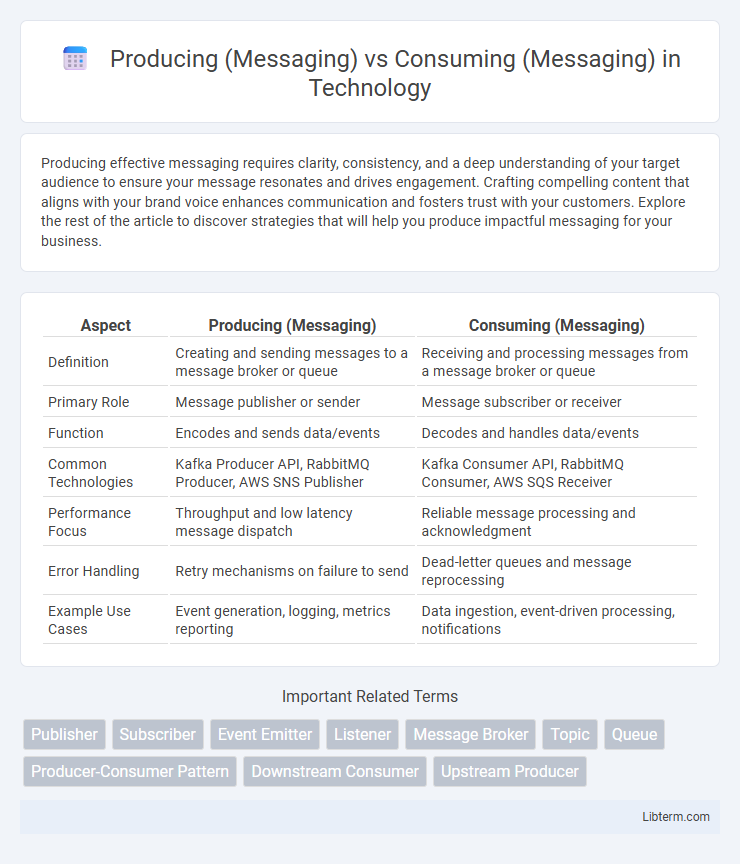Producing effective messaging requires clarity, consistency, and a deep understanding of your target audience to ensure your message resonates and drives engagement. Crafting compelling content that aligns with your brand voice enhances communication and fosters trust with your customers. Explore the rest of the article to discover strategies that will help you produce impactful messaging for your business.
Table of Comparison
| Aspect | Producing (Messaging) | Consuming (Messaging) |
|---|---|---|
| Definition | Creating and sending messages to a message broker or queue | Receiving and processing messages from a message broker or queue |
| Primary Role | Message publisher or sender | Message subscriber or receiver |
| Function | Encodes and sends data/events | Decodes and handles data/events |
| Common Technologies | Kafka Producer API, RabbitMQ Producer, AWS SNS Publisher | Kafka Consumer API, RabbitMQ Consumer, AWS SQS Receiver |
| Performance Focus | Throughput and low latency message dispatch | Reliable message processing and acknowledgment |
| Error Handling | Retry mechanisms on failure to send | Dead-letter queues and message reprocessing |
| Example Use Cases | Event generation, logging, metrics reporting | Data ingestion, event-driven processing, notifications |
Understanding the Basics of Messaging: Producing vs Consuming
Producing messaging involves creating and sending data payloads to a message broker or queue, ensuring that information is formatted, encoded, and transmitted efficiently for downstream processing. Consuming messaging refers to receiving, decoding, and processing these data payloads from a messaging system, allowing applications to react and respond to incoming information in real time. Understanding the distinction between producing and consuming is essential for designing scalable, event-driven architectures and ensuring reliable communication across distributed systems.
Key Differences Between Producers and Consumers in Messaging
Producers in messaging systems generate and send messages to queues or topics, initiating communication, while consumers receive and process these messages for further action or data handling. Key differences include the producer's role in message creation and dispatch, ensuring message formatting and delivery, contrasted with the consumer's responsibility for message retrieval, acknowledgment, and processing logic. Producers emphasize message throughput and latency in sending, whereas consumers focus on message consumption rate, error handling, and processing efficiency.
The Role of Producers in Modern Messaging Architectures
Producers in modern messaging architectures generate and send messages to communication channels, playing a critical role in initiating data flow and enabling real-time processing. By efficiently producing structured messages to queues or topics, producers ensure system scalability, fault tolerance, and decoupling between components. This setup allows for asynchronous communication and supports the orchestration of distributed microservices, enhancing overall system responsiveness and reliability.
How Consumers Process and Handle Incoming Messages
Consumers in messaging systems efficiently process incoming messages through mechanisms such as message queues, buffers, and event-driven processing to ensure timely handling and avoid bottlenecks. They utilize acknowledgment protocols and message filtering techniques to maintain data integrity and prioritize critical information. Scalability and fault tolerance are improved by implementing load balancing and retry logic, enabling consumers to handle high volumes of messages reliably.
Common Patterns in Message Production
Common patterns in message production include the use of asynchronous communication, where messages are published to queues or topics to decouple producers from consumers. Message producers often implement idempotent operations to ensure reliability and avoid duplication during retries or failures. Leveraging standardized message formats like JSON or Avro enhances interoperability and facilitates consistent parsing across various messaging systems.
Essential Consumer Design Strategies
Essential consumer design strategies emphasize clear message formatting and intuitive interface layouts to enhance message consumption efficiency. Prioritizing real-time synchronization and adaptive content delivery ensures messages remain relevant and easily accessible for consumers. Implementing scalable notification systems and personalized filtering further optimizes the user experience in consuming messaging data.
Ensuring Reliability in Message Producing and Consuming
Ensuring reliability in message producing involves implementing mechanisms such as message acknowledgments, retries, and durable message queues to prevent data loss and guarantee delivery. On the consuming side, reliable message consumption requires acknowledgement protocols, idempotent processing, and careful offset management to avoid message duplication or loss. Both producing and consuming processes must integrate fault-tolerant design and persistent storage to maintain consistent and durable message flows in distributed systems.
Security Best Practices for Producers and Consumers
Producers must ensure message encryption, use authentication protocols like TLS, and implement proper authorization controls to prevent unauthorized data injection. Consumers should validate incoming messages, apply message integrity checks such as digital signatures, and enforce strict access controls to protect against data tampering and replay attacks. Both producers and consumers benefit from secure key management practices and monitoring for anomalies to maintain end-to-end message security.
Monitoring and Scaling Message Producers and Consumers
Monitoring message producers involves tracking throughput, latency, and error rates to ensure efficient message generation and delivery, while scaling requires adjusting resources based on production load patterns and message volume spikes. For consumers, monitoring focuses on processing lag, consumer group health, and message failure rates, with scaling approaches that optimize parallelism and resource allocation to maintain timely message consumption. Employing metrics such as Kafka's consumer lag or RabbitMQ's queue depth enables proactive scaling strategies to balance workload, prevent bottlenecks, and maintain system reliability.
Real-World Use Cases: Producer and Consumer Interactions
Producer-consumer interactions in messaging systems streamline data flow by enabling producers to send structured messages to queues or topics, which consumers then asynchronously retrieve and process for tasks such as order processing, log aggregation, or real-time analytics. In e-commerce platforms, producers generate purchase events that consumers analyze to update inventory and trigger shipment workflows, ensuring decoupled scalability and reliability. Financial institutions leverage messaging patterns where producers publish market data feeds, and multiple consumers execute risk assessments and trading algorithms independently without impacting each other's processing.
Producing (Messaging) Infographic

 libterm.com
libterm.com